I had a shaft with eccentric lobes that I needed to polish after making a press on bushing for it. So I thought it would be a great opportunity to try using the 4 jaw to mount the shaft eccentrically so the lobe would be centered. So the first step was to remove the 3 Jaw. After reading about the somewhat weak low speed gears in these machines I figured I'd make a spindle clamp so no back gears were involved. I made it so it would fit on the rear of the spindle without removing the drive pulley and guard. After attaching the clamp and shoving a stand under it to hold it I proceeded to chuck a 1 inch grade 8 bolt and commenced hanging off the wrench handle. After about 2 minutes of that and adding the obligatory cheater bar (a 2" wrench hooked on the end), the clamp I made started slipping so I grabbed a F clamp to help the 3/4 " bolt that was doing all the clamping before. I could now hang off it but it would still slip a little. This was Friday night so I said enough, sprayed the spindle with penetrating oil and had a beer.
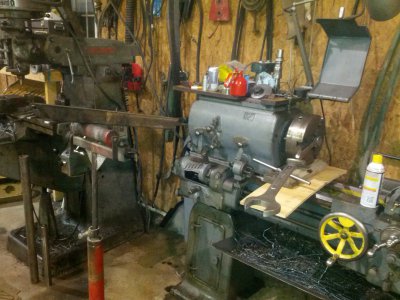
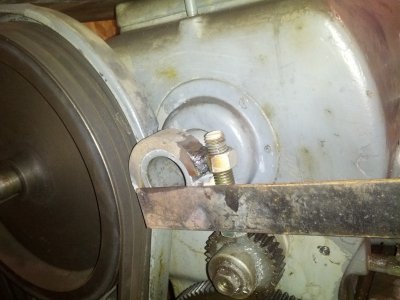
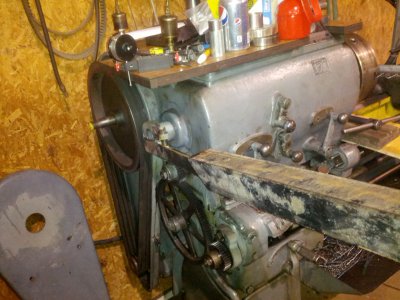
Saturday I got an assistant and after considering our options I grabbed a failed 3" wheel spindle from a farm implement and welded a 2.25" nut on the end of it. I milled 3 flat lands on it for the 3 jaw to grab. We then proceeded to put a 1 inch impact on the 2.25" nut and a 60" pipe wrench on the chucked wheel spindle. We reasoned the combined continuous torque of the pipe wrench and shock of the impact would do the job. After 15 minutes of that we decided heat was needed. Fearing for the spindle seal I was a bit leery of too much heat from the torch but we did it anyway. After 3 cycles heating, impacting and cooling the chuck was still firmly in place. Our limiting factor seemed to be the clamp on the rear of the spindle.
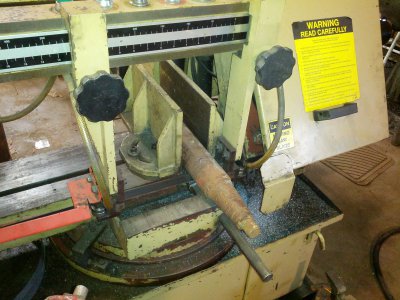
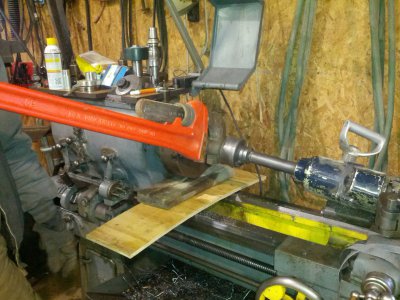
Today I started making a full length clamp for the back side of the spindle so I can get at least 2.4 inches of clamping area. I am thinking I can get 3 3/4" fine thread bolts on it for some ridiculous clamping power. Then I think I am going to remove the 3 jaw from the back plate and make a mating plate on a rotary table. I think we have already put the 3 jaw through too much abuse. I plan to weld very heavy stock of about 12" in length from the center line so we can strike it and a 3 inch square tube that is about 4 feet long for leverage.
Is there anything else we should be doing to improve our chances? One thing that does concern me is if we use a hammer to hit any lever it will place force on the spindle bearing whereas the air impact does not place a downward force on the bearing. This seems like inviting brinneling of the spindle bearing. I might just weld a 2.25" nut on the mating plate so we can still use the air impact.
If this doesn't work I am just going to cut the backing plate off the spindle and remount the 3 jaw on a new one. I am starting to think this chuck has been on this lathe since the 70's.
And I polished the shaft with the 3 jaw anyway so I don't know why I am still pursuing this..... :nuts:
Thanks and Regards,
Matt








Saturday I got an assistant and after considering our options I grabbed a failed 3" wheel spindle from a farm implement and welded a 2.25" nut on the end of it. I milled 3 flat lands on it for the 3 jaw to grab. We then proceeded to put a 1 inch impact on the 2.25" nut and a 60" pipe wrench on the chucked wheel spindle. We reasoned the combined continuous torque of the pipe wrench and shock of the impact would do the job. After 15 minutes of that we decided heat was needed. Fearing for the spindle seal I was a bit leery of too much heat from the torch but we did it anyway. After 3 cycles heating, impacting and cooling the chuck was still firmly in place. Our limiting factor seemed to be the clamp on the rear of the spindle.


Today I started making a full length clamp for the back side of the spindle so I can get at least 2.4 inches of clamping area. I am thinking I can get 3 3/4" fine thread bolts on it for some ridiculous clamping power. Then I think I am going to remove the 3 jaw from the back plate and make a mating plate on a rotary table. I think we have already put the 3 jaw through too much abuse. I plan to weld very heavy stock of about 12" in length from the center line so we can strike it and a 3 inch square tube that is about 4 feet long for leverage.
Is there anything else we should be doing to improve our chances? One thing that does concern me is if we use a hammer to hit any lever it will place force on the spindle bearing whereas the air impact does not place a downward force on the bearing. This seems like inviting brinneling of the spindle bearing. I might just weld a 2.25" nut on the mating plate so we can still use the air impact.
If this doesn't work I am just going to cut the backing plate off the spindle and remount the 3 jaw on a new one. I am starting to think this chuck has been on this lathe since the 70's.
And I polished the shaft with the 3 jaw anyway so I don't know why I am still pursuing this..... :nuts:
Thanks and Regards,
Matt







![IMG_20121119_223402[1].jpg IMG_20121119_223402[1].jpg](https://www.hobby-machinist.com/data/attachments/10/10349-b9164e73117e038a8b08f1fbddd1164e.jpg)
![IMG_20121119_223049[1].jpg IMG_20121119_223049[1].jpg](https://www.hobby-machinist.com/data/attachments/10/10350-eb8eebe43547337677b5dccb7c193242.jpg)
![IMG_20121119_223014[1].jpg IMG_20121119_223014[1].jpg](https://www.hobby-machinist.com/data/attachments/10/10351-578cd46345a3afb9dc4ecec3117198f7.jpg)
![IMG_20121119_223450[1].jpg IMG_20121119_223450[1].jpg](https://www.hobby-machinist.com/data/attachments/10/10348-0f2cf7b6f9553f0249173df6e042bb6f.jpg)